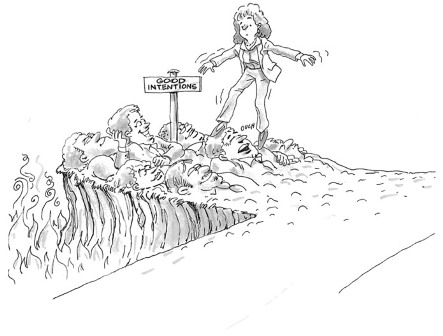
The Road to Hell Is Paved with Good Intentions

Once people determine that what they want is not happening or that what they don’t want is happening, their behavior becomes more extreme and goes into the Danger Zone. Let’s observe how threatened or thwarted positive intentions lead to the behaviors of difficult people.
Threatened Intent to Get It Done
Through the distorted lens of the thwarted intent to get it done, others appear to be wasting time, going off on tangents, or just plain taking too long. The intent increases in intensity, and the subsequent behavior becomes more controlling. The three most difficult controlling behaviors are the Tank, Sniper, and Know-It-All.
The Tank. On a mission, unable to slow down, pushing you around, or running right over you, the Tank has no inhibitions about ripping you apart personally. Yet the irony is ... it’s not personal. You just happened to get in the way. In an effort to control the process and accomplish the mission, Tank behavior ranges from mild pushiness to outright aggression.
The Sniper. Strategists when things aren’t getting done to their satisfaction, Snipers attempt to control you through embarrassment and humiliation. Most people live in fear of public embarrassment—a fact that Snipers use to their advantage, by making loaded statements and sarcastic comments at times when you are most vulnerable.
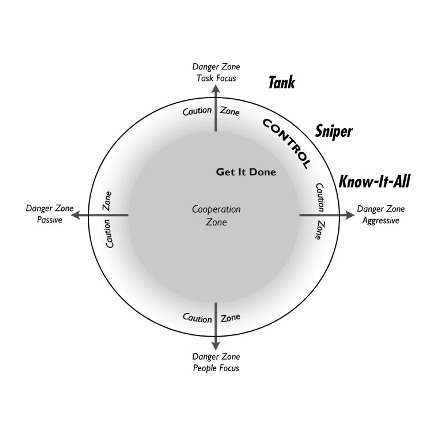
The Know-It-All. Know-It-Alls control people and events by dominating the conversation with lengthy, imperious arguments, and they eliminate opposition by finding flaws and weaknesses to discredit other points of view. Because Know-It-Alls are actually knowledgeable and competent, most people are quickly worn down by their strategy and finally just give up.
Threatened Intent to Get It Right
Through the distorted lens of the thwarted intent to get it right, everything around these people begins to seem haphazard and careless. To add insult to injury, people seem to address these concerns with horrifyingly fuzzy words, like pretty much, and roughly, and probably. When sufficient intensity is reached, the behavior becomes increasingly pessimistic and perfectionistic. The Whiner, the No Person, the Judge, and the Nothing Person, all exemplify this kind of behavior.
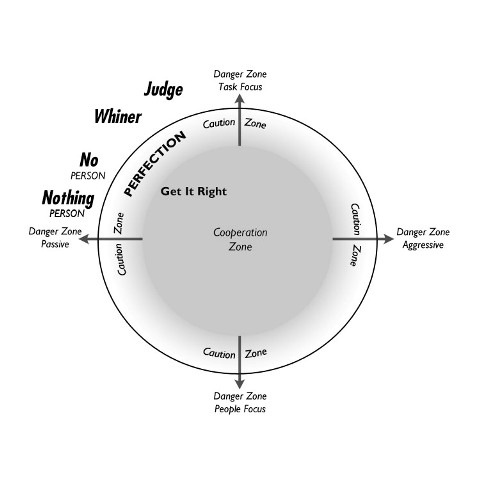
The Whiner. In our imperfect world, Whiners believe that they are powerless to create change. Burdened and overwhelmed by all the uncertainty around what can go wrong, they abandon all thought of solutions. Instead, as the feeling of helplessness increases, they focus on any problems they can use as evidence for their massive generalization. They begin to whine: “Oh, ... nothing is right. Everything is wrong.” This, of course, serves only to drive everybody else crazy, and the deteriorating situation provokes further whining.
The No Person. Unlike Whiners, No People do not feel helpless in the face of things going wrong. Instead, the No People become hopeless. Certain that what is wrong will never be set right, they have no inhibition about letting others know how they feel: “Forget it, we tried that. It didn’t work then, it won’t work now, and you’re kidding yourself if anyone tells you something different. Give up and save yourself from wasted effort on a lost cause.” This gravity well pulls others into the No People’s personal pits of despair.
The Judge. Unlike Whiners and No People, Judges are not caught up in generalizations that nothing is right. Instead, their attention is on specific areas where they have decided that you are not measuring up. Judges can range in behavior from nitpicking (focused on details of no real consequence) to condemning you and then writing you off. Unconstructive criticism is their specialty. They may express their judgments directly to you or to others behind your back.
The Nothing Person. When events fail to measure up to their standard of perfection, some people get so totally frustrated that they withdraw completely. There may be one last shout at the powers-that-be for failing to get it right: “Fine! Do it your way. Don’t come crying to me if it doesn’t work out!” From that point on, they do and say ... nothing.
Threatened Intent to Get It Right and Get It Done
Not all behaviors are based on a single motivation. When people straddle the line between get it right and get it done, they can view you through a critical eye, judge you of being incapable of doing what needs to be done, and then take over.
The Meddler. When you combine the critical perfectionist eye of the Judge with the get it done controlling nature of a Tank, you get a Meddler. These people know what’s best for you and insert themselves into your life and try to get you to do what they are sure you need to be doing. They can range from nosy to interfering to manipulative. From what you wear, to whom you spend time with, to how you talk, to what you do, the Meddler is keeping an eye on you.
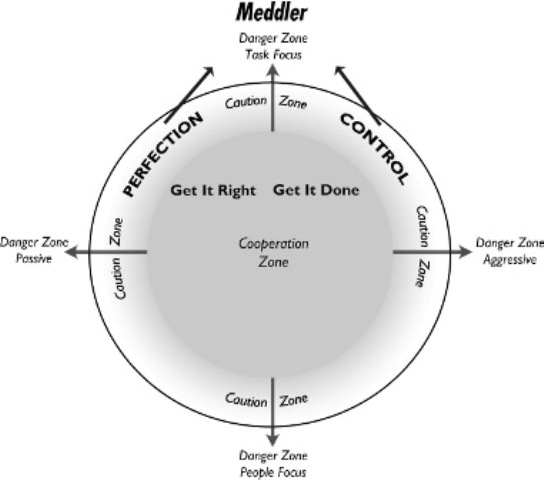
Threatened Intent to Get Along with Others
Through the distorted lens of the thwarted intent to get along with people, uncertainty about how others feel about them leads them to take other people’s reactions, comments, and facial expressions personally. Behavior becomes increasingly geared toward gaining approval and avoiding disapproval. The three most difficult approval-seeking behaviors are the passive Nothing Person, the wishy-washy Yes Person, and the Maybe Person.
The Nothing Person. Timid, uncomfortable, and uncertain, get along Nothing People excel at tongue biting. Since they don’t have anything nice to say, they don’t say anything at all. At their worst, they say nothing almost all the time. This, in many ways, is the perfect strategy to avoid conflict, to avoid hurting someone else’s feelings, and to keep from angering anyone. It’s almost a perfect plan, but there is a fly in the ointment. Since Nothing People can’t relate authentically or speak honestly, they don’t really get along with anyone.
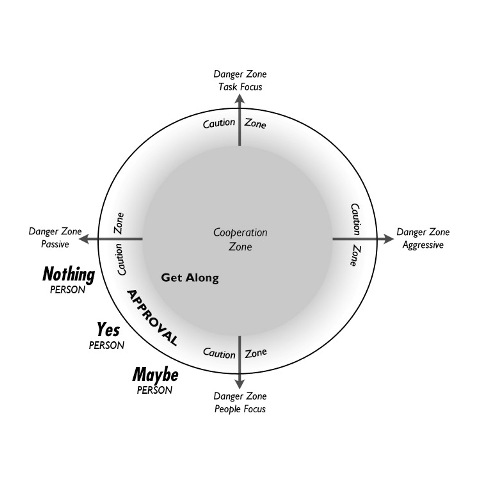
The Yes Person. Yes People seek approval and avoid disapproval by trying to please everyone else. The Yes People answer yes to every request, without actually thinking about what is being promised or the consequences of failing to follow through. “Sure,” say the Yes People. And to the next request, “Okay,” and “Of course,” to the next request. Before long, the Yes People have overpromised and under-delivered to such an extent that the very people they wanted to get along with are furious. In the rare instance where the promises are kept, Yes People’s lives are no longer their own because all their choices are made around everyone else’s needs and demands. This produces a deep-seated anxiety and much resentment in the Yes People, which can even lead to unconscious acts of sabotage.
The Maybe Person. Maybe People avoid disapproval by avoiding decisions. After all, the wrong choice might upset someone, or something could go wrong and who would be blamed? The solution is to put the decision off, waffle, and hedge until someone else makes the decision or the decision makes itself. Like all the other difficult behaviors, this behavior perpetuates the problem it is intended to solve by causing so much frustration and annoyance that the Maybe People are locked out of meaningful relationships with others.
Threatened Intent to Get Appreciated by People
Through the distorted lens of a thwarted intent to get appreciation from people, the lack of positive feedback combines in their mind with the reactions, comments, and facial expressions of others, and it all tends to be taken personally. The intent to get appreciation intensifies in direct proportion to the lack of appreciative feedback, and the behavior becomes increasingly aimed at getting attention. The three most difficult attention-getting behaviors that result from the thwarted desires to get appreciation are the Grenades, the Snipers, and the Think-They-Know-It-Alls.
The Grenade. They say they don’t get any appreciation and they’re not getting any respect. When the silence and lack of appreciation become deafening, look out for the Grenade: the adult temper tantrum. “Kaboom! @#$* Nobody around here cares! That’s the problem with the world today. Kapow! *%^&@# I don’t know why I even bother! No one appreciates just how hard it is for me! Katung! &%$#*.” Ranting and raving are difficult to ignore. But since this desperate behavior produces negative attention and disgust, the Grenade is ever more likely to blow up at the next provocation.
The difference between the Tank, described earlier, and the Grenade is that the Tank uses focused fire in a single direction, while the Grenade produces an out-of-control explosion in 360 degrees. The Tank takes aim with specific charges but leave other useful people and office equipment standing. The Grenade introduces elements that have little or nothing to do with the present circumstances. A Tank attack is a demand for action. A Grenade tantrum is a demand for attention.
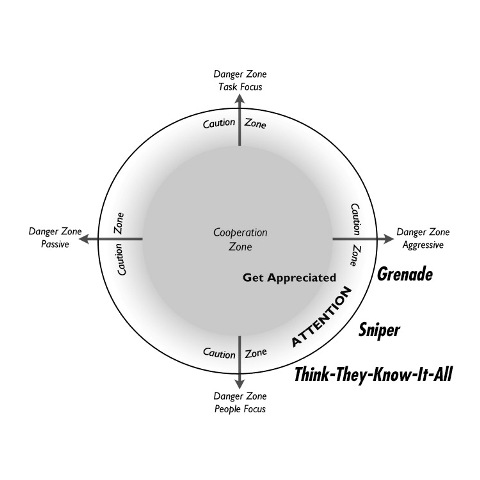
The Friendly Sniper. These Snipers actually like you, and their sniping is a “fun way” of gaining attention. “I never forget a face ..., but in your case I will make an exception.” Many people have relationships that include playful sniping. Normally, the best defense is a good offense because instead of offending, a return snipe is a sign of appreciation. But if people on the receiving end don’t give or receive appreciation in this manner, they may be laughing on the outside while bleeding from an emotional wound on the inside.
The Think-They-Know-It-All. Think-They-Know-It-Alls are specialists in exaggerations, half truths, jargon, useless advice, and unsolicited opinions. Charismatic and enthusiastic, these desperate-for-attention people can persuade and mislead an entire group of naive people into serious difficulties. If you argue with them, they turn up the volume and dig in their heels, then refuse to back down until you look as foolish as they do.
Threatened Intent to Get Appreciated and Get Along
Straddling the line between the intent to get appreciated and the intent to get along creates a tension that causes people to go out of their way to please and help others, while also desperately wanting the appreciation for doing so in return.
The Martyr. Martyrs can be pleasant on the surface, as they go about doing everything for everybody. But what they really seek is appreciation and significance in the lives of others. Unfortunately the things they do are not necessarily what others want done, and so they often don’t get the appreciation they desire. This finally leads to a Martyr meltdown, when they complain that they do everything for everybody and question why no one cares about them.
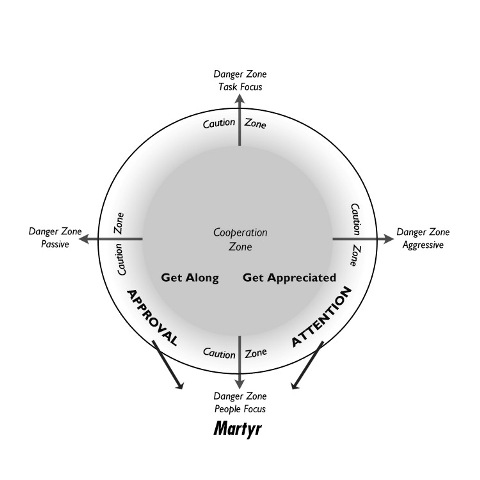
To Summarize
• Behavior becomes more controlling when the intent to get it done is thwarted, leading people to become Tanks, Snipers, and Know-It-Alls.
• Behavior becomes more perfectionistic when the intent to get it right is thwarted, leading people to become Whiners, No People, Judges, and Nothing People.
• Behavior becomes more perfectionistic and more controlling when the intent to get it right and get it done is thwarted, leading people to become Meddlers.
• Behavior becomes more approval seeking when the intent to get along is thwarted, leading people to become Yes People, Maybe People, and Nothing People.
• Behavior becomes more attention getting when the intent to get appreciation is thwarted, leading people to become Grenades, Think-They-Know-It-Alls, and Snipers.
• Behavior becomes more attention-getting and more approval-seeking when the intent to get appreciated and get along is thwarted, leading people to become Martyrs.
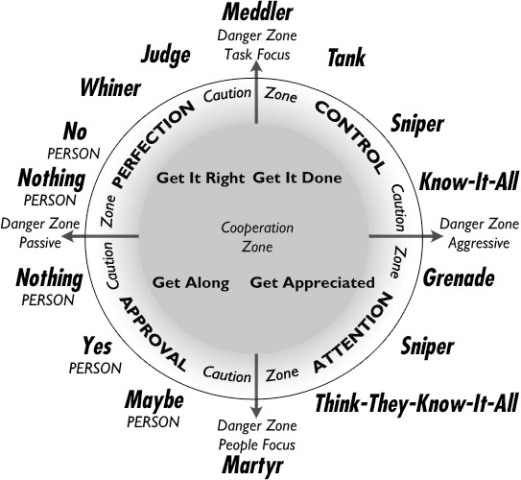
*Find a color printout of the Lens of Understanding at www.DealingWithPeople.com.
As you read these descriptions of the 10 (A 3) difficult behaviors that people can’t stand, perhaps you noticed that when your intentions are thwarted, you occasionally become some of these people too—we wouldn’t be surprised since everybody is somebody’s difficult person some of the time. Who hasn’t whined; complained; become hopeless; exaggerated a story; withheld their true feelings; felt ignored, put upon, or dismissed; procrastinated in making a decision; lost their temper; loudly accused; or withdrawn completely? The difference between you and your difficult people in this regard may be a matter of degree and frequency, or recognition and responsibility. But the essential point here is that these behaviors are observable and changeable.
The behavior of the people you can’t stand is determined by their perception of what they think is going on as it relates to what they think is important. Their behavior interacts with your behavior, which is based on your own perception of these same variables. This produces an outcome, either randomly or intentionally. The results of your dealings with people at their worst is, in large measure, up to you.